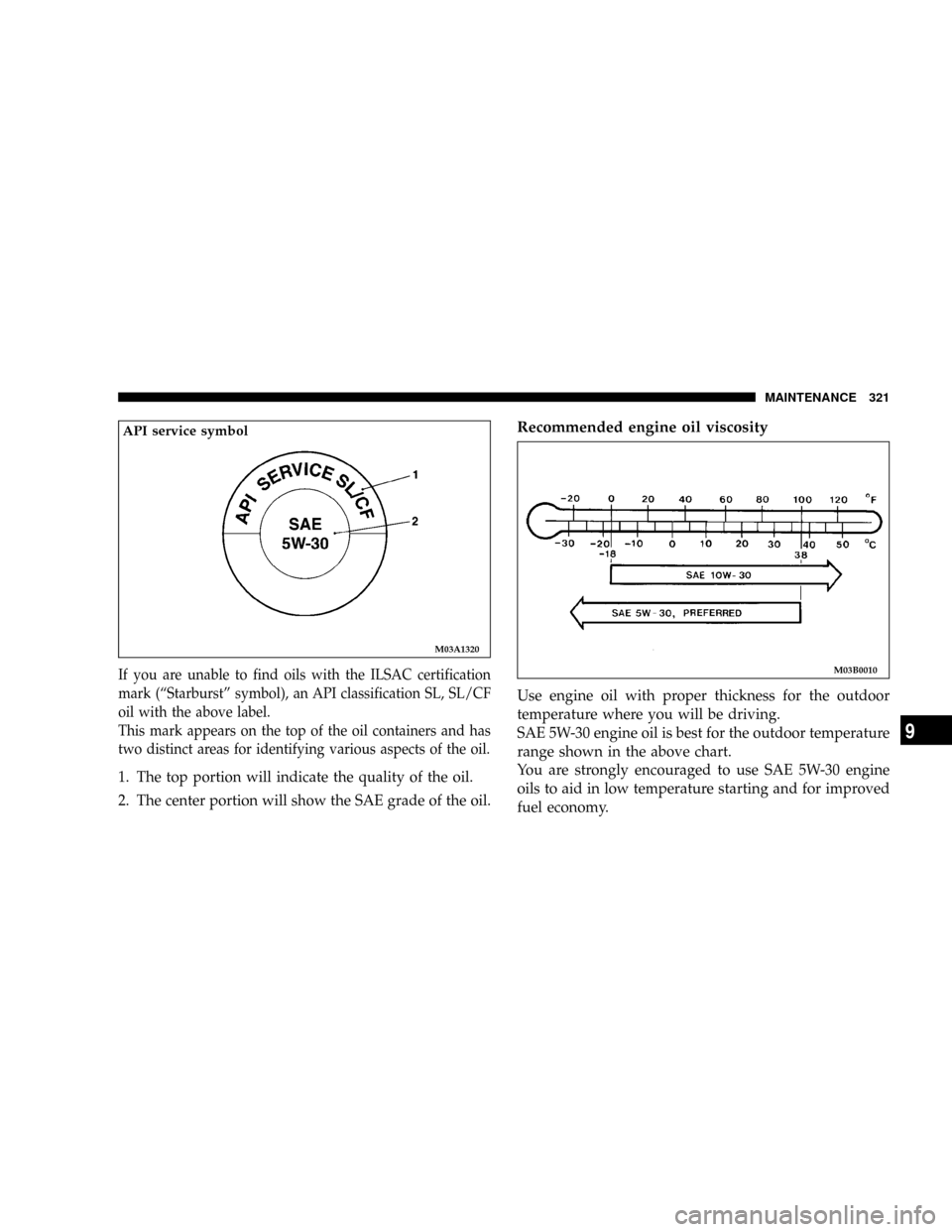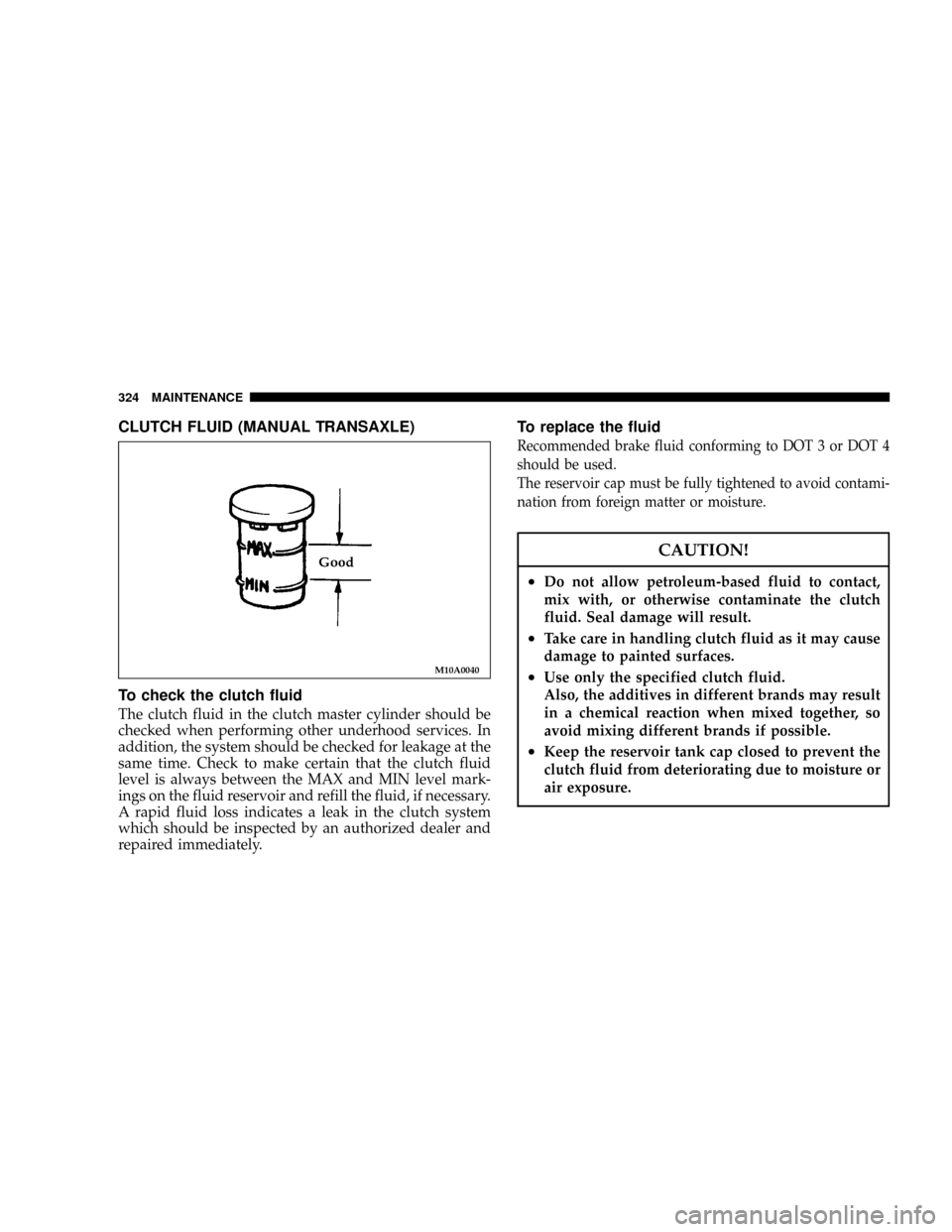2004 DODGE STRATUS COUPE service
[x] Cancel search: servicePage 314 of 388

EMISSIONS TESTING
In some localities, it may be or will become a legal
requirement to ensure that all emissions components and
systems are functioning properly as a part of the test
procedure. The test center accomplishes this by checking
the On Board Diagnostic System system (OBD) with an
electronic scan tool. If your vehicle has recently been
serviced, the OBD system may have been reset to a9not
ready9condition because the OBD system has not had
sufficient time since the servicing to reconfirm that
emissions components are operating properly. In most
cases, a reasonable mix and amount of normal city and
highway driving and at least one overnight-off period
will be required to prepare your vehicle for this check;
however your authorized dealer has the equipment and
procedures required to make certain that the OBD system
of your vehicle is ready for the required testing.
ONBOARD DIAGNOSTIC SYSTEM (OBD II)
To meet new government regulations and promote
cleaner air, your vehicle is equipped with a sophisticated
onboard diagnostic system called OBD II. This system
monitors the performance of the emissions, engine, andautomatic transaxle control systems. When these systems
are operating properly, your vehicle will provide excel-
lent performance and fuel economy, as well as engine
emissions well within current government regulations.
If any of these systems require service, the
OBD II system will turn on the Malfunction
Indicator Light. It will also store diagnostic
codes and other information to assist your
service technician in making repairs. Al-
though your vehicle will usually be driveable and not
need towing, see your dealer for service as soon as
possible.
CAUTION!
Prolonged driving with the light on could cause
further damage to the emission control system. It
could also affect fuel economy and driveability. The
vehicle must be serviced before any state emissions
tests can be performed.
314 MAINTENANCE
Page 315 of 388

If the light is flashing, severe catalytic converter damage
and power loss will soon occur. Immediate service is
required.
If the gas cap is not tightened properly, the light may
come on. Be sure the gas cap is tightened every time you
add fuel. Tighten the cap until you hear it ªclick.º
REPLACEMENT PARTS
Use of genuine Mopar parts for normal/scheduled main-
tenance and repairs is highly recommended to insure the
designed performance. Damage or failures caused by the
use of non-Mopar parts for maintenance and repairs will
not be covered by the manufacturers warranty.
Fuel system (tank, filler tube, connections, and
fuel tank filler cap)
Check periodically for damage or leakage in the fuel lines
and connections, and check for damage and looseness of
the fuel tank filler tube cap. Particular attention should be
paid to examining those fuel lines nearest to high heat
sources such as the exhaust manifold.
WARNING!
If you see a fuel leak or if you smell fuel, do not
operate the vehicle. Any spark (including from the
ignition ), flame or smoking material could cause an
explosion or fire. Call an authorized dealer for
assistance.
Fuel hoses
Inspect the surfaces of hoses for evidence of heat and
mechanical damage, hard and brittle rubber, cracking,
tears, cuts and abrasions. Particular attention should be
paid to examining those hose surfaces nearest to high
heat sources such as the exhaust manifold. Inspect all
hose connections, such as clamps and couplings, to make
sure they are secure and that no leaks exist. If there is any
evidence of deterioration or damage, hoses should be
replaced immediately.
MAINTENANCE 315
9
Page 318 of 388

GENERAL MAINTENANCE
The following pages contain the maintenance service
recommended by the manufacturer. In addition to the
general maintenance items for which fixed maintenance
intervals have been specified, there are other items which
are expected to operate satisfactorily without periodic
maintenance.
However, if a malfunction of these items does occur, it
could adversely affect the engine or vehicle performance.
These items should be inspected if a malfunction is
observed or suspected.
See your authorized dealer for assistance, if you have any
questions.
Engine oil and oil filter
M03A0700
2.4 liter engine
Good
318 MAINTENANCE
Page 321 of 388

If you are unable to find oils with the ILSAC certification
mark (ªStarburstº symbol), an API classification SL, SL/CF
oil with the above label.
This mark appears on the top of the oil containers and has
two distinct areas for identifying various aspects of the oil.
1. The top portion will indicate the quality of the oil.
2. The center portion will show the SAE grade of the oil.
Recommended engine oil viscosity
Use engine oil with proper thickness for the outdoor
temperature where you will be driving.
SAE 5W-30 engine oil is best for the outdoor temperature
range shown in the above chart.
You are strongly encouraged to use SAE 5W-30 engine
oils to aid in low temperature starting and for improved
fuel economy.
M03A1320
API service symbol
M03B0010
MAINTENANCE 321
9
Page 322 of 388

ENGINE COOLANT
To check the coolant level
The coolant reserve system provides a quick visual
method for determining the coolant level. When the
engine is cold, the level of the coolant in the reserve tank
should be between the FULL and LOW marks. The
radiator normally remains completely full so there is no
need to remove the radiator cap except for checking the
coolant freeze point or replacing the antifreeze coolant.
To add coolant
Use DaimlerChrysler Genuine Coolant or an equivalent.
Genuine Coolant provides excellent protection against
corrosion and rust formation of all metals, including
aluminum, and prevents clogs in the radiator, heater,
cylinder head, engine block, etc.
If frequent coolant additions are required, or if the level
in the reserve tank does not drop when the engine cools,
the system should be pressure-tested for leaks. Take your
vehicle to an authorized dealer for inspection of the
cooling system.
CAUTION!
²Do not use alcohol or methanol anti-freeze or any
engine coolants mixed with alcohol or methanol
anti-freeze. The use of an improper anti-freeze can
cause corrosion of aluminum components.
²When additional coolant is needed to maintain
the proper level, a minimum of 50% concentration
of ethylene-glycol antifreeze in water should be
added to the reserve tank. Do not overfill. A
higher concentration (not to exceed 60%) should
be used if a lower freezing point is required. The
concentration level can be checked using instru-
ments available at automotive supply stores, or
can be done by your authorized dealer or service
station. Use only high quality ethylene-glycol
antifreeze coolant formulated to prevent corrosion
of all cooling system metals.
²Do not top off with water only. Water by itself
reduces the rust-protective and anti-freeze quali-
ties of the coolant and has a lower boiling point. It
can also cause damage to the cooling system if it
should freeze. Do not use tap water, as it may
cause corrosion and rust formation.
322 MAINTENANCE
Page 324 of 388

CLUTCH FLUID (MANUAL TRANSAXLE)
To check the clutch fluid
The clutch fluid in the clutch master cylinder should be
checked when performing other underhood services. In
addition, the system should be checked for leakage at the
same time. Check to make certain that the clutch fluid
level is always between the MAX and MIN level mark-
ings on the fluid reservoir and refill the fluid, if necessary.
A rapid fluid loss indicates a leak in the clutch system
which should be inspected by an authorized dealer and
repaired immediately.
To replace the fluid
Recommended brake fluid conforming to DOT 3 or DOT 4
should be used.
The reservoir cap must be fully tightened to avoid contami-
nation from foreign matter or moisture.
CAUTION!
²Do not allow petroleum-based fluid to contact,
mix with, or otherwise contaminate the clutch
fluid. Seal damage will result.
²Take care in handling clutch fluid as it may cause
damage to painted surfaces.
²Use only the specified clutch fluid.
Also, the additives in different brands may result
in a chemical reaction when mixed together, so
avoid mixing different brands if possible.
²Keep the reservoir tank cap closed to prevent the
clutch fluid from deteriorating due to moisture or
air exposure.
M10A0040
Good
324 MAINTENANCE
Page 330 of 388

DOOR HINGES, REAR HATCH HINGES, HOOD
LOCK RELEASE MECHANISM AND SAFETY
CATCH
The door hinges, trunk hinges, hood lock release mecha-
nism and hood safety catch should be inspected, cleaned,
and lubricated as required to maintain ease of operation
and to provide protection against rust and wear. Apply
engine oil to door hinges, hood hinges, and trunk hinges.
Apply Multipurpose Grease NLGI Grade 2 sparingly to
all sliding contact areas of the hood latch and release
lever. Work lubricant into the hood lock mechanism until
all frictional surfaces are covered.
Also, apply a film of the same lubricant to the pivot
contact areas of the safety catch.
EXHAUST SYSTEM
WARNING!
Carbon monoxide gas found in the vehicle's exhaust
is poisonous. Inhalation of exhaust fumes can cause
unconsciousness or death.
The best protection against carbon monoxide entry into
the vehicle interior is a properly maintained engine
exhaust system.
Whenever a change is noticed in the sound of the exhaust
system; when exhaust fumes can be detected inside the
vehicle; or when the underside or rear of the vehicle is
damaged, have a competent technician inspect the com-
plete exhaust system and adjacent body areas for broken,
damaged, deteriorated, or mispositioned parts.
In addition inspect the exhaust system each time the
vehicle is raised for lubrication or oil change. Replace as
required.
Open seams or loose connections could permit danger-
ous exhaust fumes to seep into the trunk and passenger
compartments.
Do this service when performing underbody service.
Check for any of the following conditions:
1. Check for holes or exhaust gas leakage caused by
corrosion or damage.
2. Check the joints and connections for looseness or
exhaust gas leakage.
3. Check the rubber hangers and brackets for damage.
330 MAINTENANCE
Page 342 of 388

!30,000 Miles (48 000 km) or at 30 months
NReplace air cleaner filter.
NReplace spark plugs, standard type.
NCheck drive belts condition (for the generator,
water pump, power steering pump).
NCheck manual transaxle oil level.
NCheck coolant hoses (radiator hose, heater hose).
NCheck fuel hoses condition.
NInspect rear drum brake linings and rear wheel
cylinders (except vehicles with disc brakes) for
wear and leaks of all wheels.
NInspect ball joint and steering linkage seals for
grease leaks and damage.
NInspect suspension system for looseness and dam-
age.
NCheck and service exhaust system as required
(connection portion of muffler, muffler pipes and
converter heat shields).
MILEAGE/
MONTHSDEALERSHIP
NAME/CODE DATEREPAIR
ORDER #
!30,000 Miles (48 000 km) or at 30 months
NChange engine oil and engine oil filter.
NRotate tires.
MILEAGE/
MONTHSDEALERSHIP
NAME/CODE DATEREPAIR
ORDER #
!36,000 Miles (58 000 km) or at 36 months
NCheck automatic transaxle fluid level.
NInspect disc brake pads, rotors and calipers for
wear and leaks.
NCheck brake hoses for deterioration or leaks.
NInspect drive shaft boots for grease leaks and damage.
NChange engine oil and engine oil filter.
NRotate tires.
MILEAGE/
MONTHSDEALERSHIP
NAME/CODE DATEREPAIR
ORDER #
342 MAINTENANCE